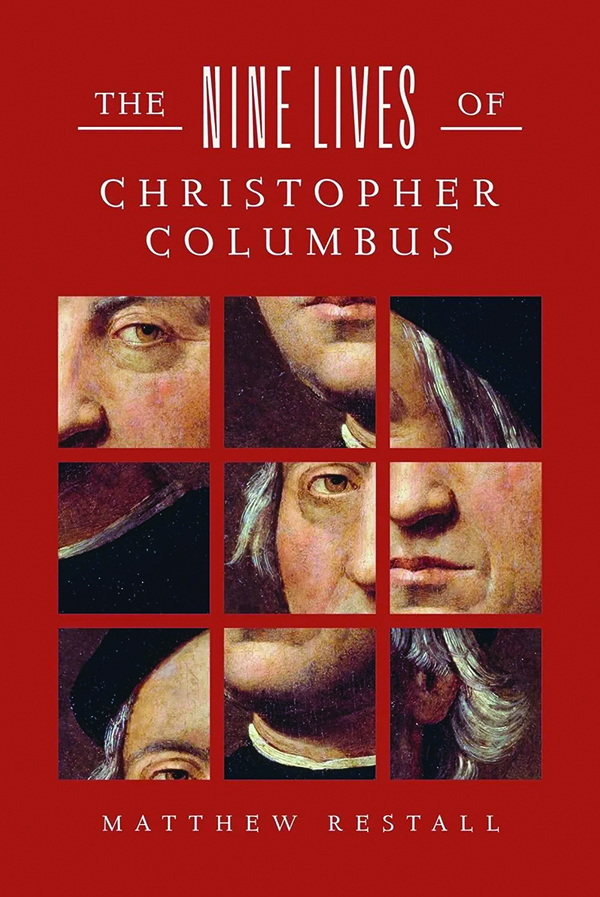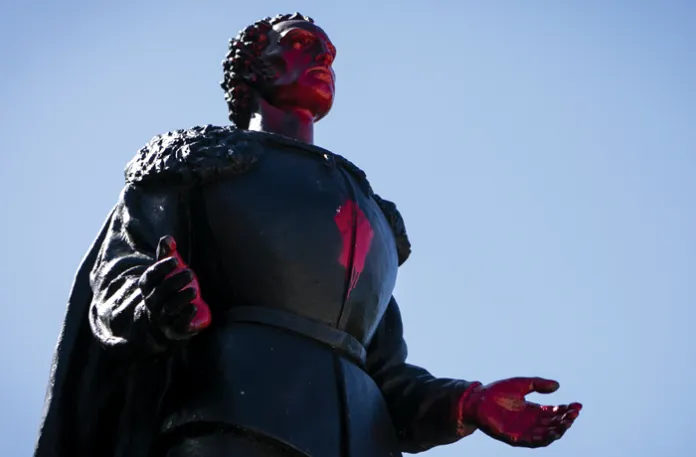In 1492, Christopher Columbus sailed the ocean blue. And however difficult that first voyage with the Niña, Pinta, and Santa Maria was, it was a pleasure cruise compared to the rough seas he’s had to navigate over the past three or four decades, a period during which his reputation has gone from one of history‘s greatest heroes to one of its worst villains. Once celebrated for his accomplishments, he is now condemned for them, indicted as instigator and mastermind of colonialism, imperialism, genocide, and a host of other maladies that have afflicted humanity ever since he set sail. The evil of the West incarnate, Columbus has become the personification of that most infamous of monsters: the dead white European male.
While this iconoclasm may seem to be a late 20th-century development (one that culminated in the 21st century with the destruction of multiple statues of the Genoese mariner during the George Floyd riots in 2020), turbulence on Columbus’s journey to posterity is by no means a new phenomenon. As Matthew Restall makes clear in The Nine Lives of Christopher Columbus, an informative and often eyebrow-raising new study of the many faces Columbus has worn — and been made to wear — over the years, debate about the nature and significance of the man and his achievement began almost as soon as he set foot back in Spain. People, it turns out, have been fighting over Columbus’s remains for centuries.
Restall’s subject isn’t Columbus, but what he calls “Columbiana,” the detritus of fantasy, rumor, innuendo, and falsehood that has accreted around him for the last 500 years. These “misconceptions and myths,” he avers, are the reason Columbus has “become more alive, more present, through the past five centuries,” especially the last two. But in one of Columbiana’s numerous ironies, it has thrived precisely the more detached it has become from Columbus the person, rife as it is with “fakery, pseudoscience, and pseudohistory,” not to mention its fair share of “conspiracy theories.”

Restall, a historian of precolonial Mesoamerica and the Spanish conquest who teaches at Penn State University, divides his book into the nine “lives” of the title, though they might be better understood as avatars or guises by which Columbus has embodied the various faces of Columbiana. Only the first two, “The Genoese” and “The Admiral,” in which Restall surveys Columbus’s life and background, bear the visage of the man himself. Contrary to one of Columbiana’s oldest “truths” that he was a veritable cipher, Columbus “is in fact abundantly evidenced” in the documentary record. That the canard we know next to nothing about him nevertheless persists is in no small part Columbus’s own doing. His clumsy attempts, once he made it, to obscure his humble and foreign origins and emphasize his status as a (newly minted) Spanish noble played a substantial part in creating the imperishable “mythistorical” truth (to use Restall’s term) that we know little about his biography. Columbus, therefore, may reasonably be considered the first contributor to Columbiana. Into the breach he opened, an army of scholars, cranks, knaves, politicians, and promoters has been charging ever since.
The next chapter, “The Remains,” details two centuries-long disputes: the competition to be declared Columbus’s true resting place (Santo Domingo, Havana, and Seville can all make cases) and the interminable legal fight between his heirs over his estate. Jarndyce v. Jarndyce was the stuff of small claims compared to this protracted conflict, which only petered out in the 1800s. Given the quarrel over his relics, it’s fitting that the following chapter is “The Saint,” in which Restall investigates the question of Columbus’s religious views while recounting the forgotten 19th-century campaign to have Columbus canonized. In one of those twists that is a regular feature of Columbiana, this quest was initiated not by an Italian or Spaniard but by a Frenchman.
Columbus was many things, but he was not a ladies’ man. But that hasn’t stopped centuries of salacious gossip painting him as something of a lothario, which Restall rebuts in “The Lover.” Amorous escapades attributed to him, from a secret dalliance with Queen Isabella to accusations that he engaged in carnal relations with manatees because he believed they were mermaids (a popular topic on TikTok, according to Restall), are all invented. The great seafarer’s existence was one “remarkably devoid of sex and romance.” What he lusted after was glory, fame, and establishing a noble lineage he could bestow on his sons.

Any town, region, or kingdom that could claim Columbus as born and bred would partake in its own share of glory, fame, and nobility. “The Local” and “The Iberian” are Restall’s atlas of places that have sought to adopt Columbus, yielding, among others, Columbus the Corsican, the Jew, the Swede, and the secret scion of leading aristocratic or even royal families. Greece, England, Portugal, and Madeira have also been attested as his birthplace. As Restall observes, some of the claims “have an internal tension to them.” Columbus the Castilian (i.e., Spaniard), for example, sits uneasily with Columbus the proud Gallego (i.e., native of Galicia).
Columbus may have discovered America, but not even a flimsy case can be made that he was born there. Nonetheless, that is arguably where he has been honored the most. In the penultimate chapter, “The Adam,” Restall traces his transformation during the 19th century into a “nationalist icon” as progenitor “of the history that gave birth to the United States.” Columbus revealed the New World, and thus bequeathed to the United States its manifest destiny. Restall’s final “life,” “The Italian,” describes how Columbus shifted “from an imperial hero to an ethnic one,” as Italian immigrants embraced him as a talisman of and vehicle for their integration into American society.
Five hundred years on from his death, concludes Restall, the statues and monuments to Columbus, documents about him, and even his bones tend to serve as little more than “war matériel in battles that ultimately have little to do with him.” It’s almost as though Columbus as myth or totem is more important than Columbus as man or historical figure. Restall doesn’t frame it in these terms, but the “lives” of Columbus usually fulfilled some need on the part of their makers, be it psychological, religious, political, or social. “Saint Christopher” arose as a response to surging anticlericalism in 19th-century Europe. Columbus the Italian was the Italian Americans’ bid for assimilation in, and acceptance by, their new nation. “The Local” advanced myriad particularist, regional, and nationalist aspirations. “We have always seen Columbus the way we want to see him. He has been painted, drawn, and sculpted in the image of the creator,” and written that way, too, Restall says. This process of fabrication has been going on for half a millennium.
One can argue that any truly significant historical personage must attain the stuff of legend if they are to live on through the ages. With Columbus, it’s legends all the way down, from the hoary fable about the flat Earth and the romantic fiction that Isabella pawned her jewels to fund his initial voyage to his alleged assignations with marine life. Perhaps the best way to think of Columbiana, then, is as lore, the collection of a thousand and one just so stories that, like moths, flit about Columbus’s flame.
Varad Mehta is a writer and historian. He lives in the Philadelphia area. Find him on X @varadmehta.

